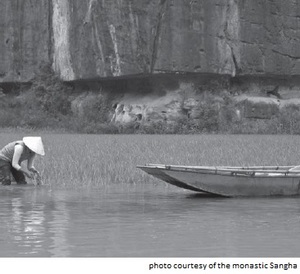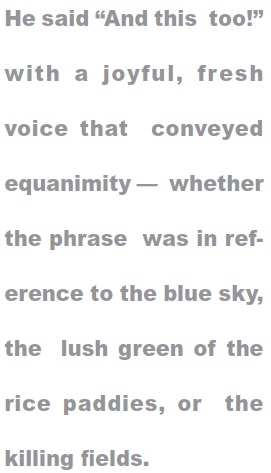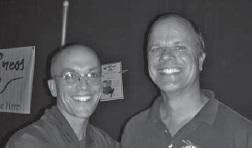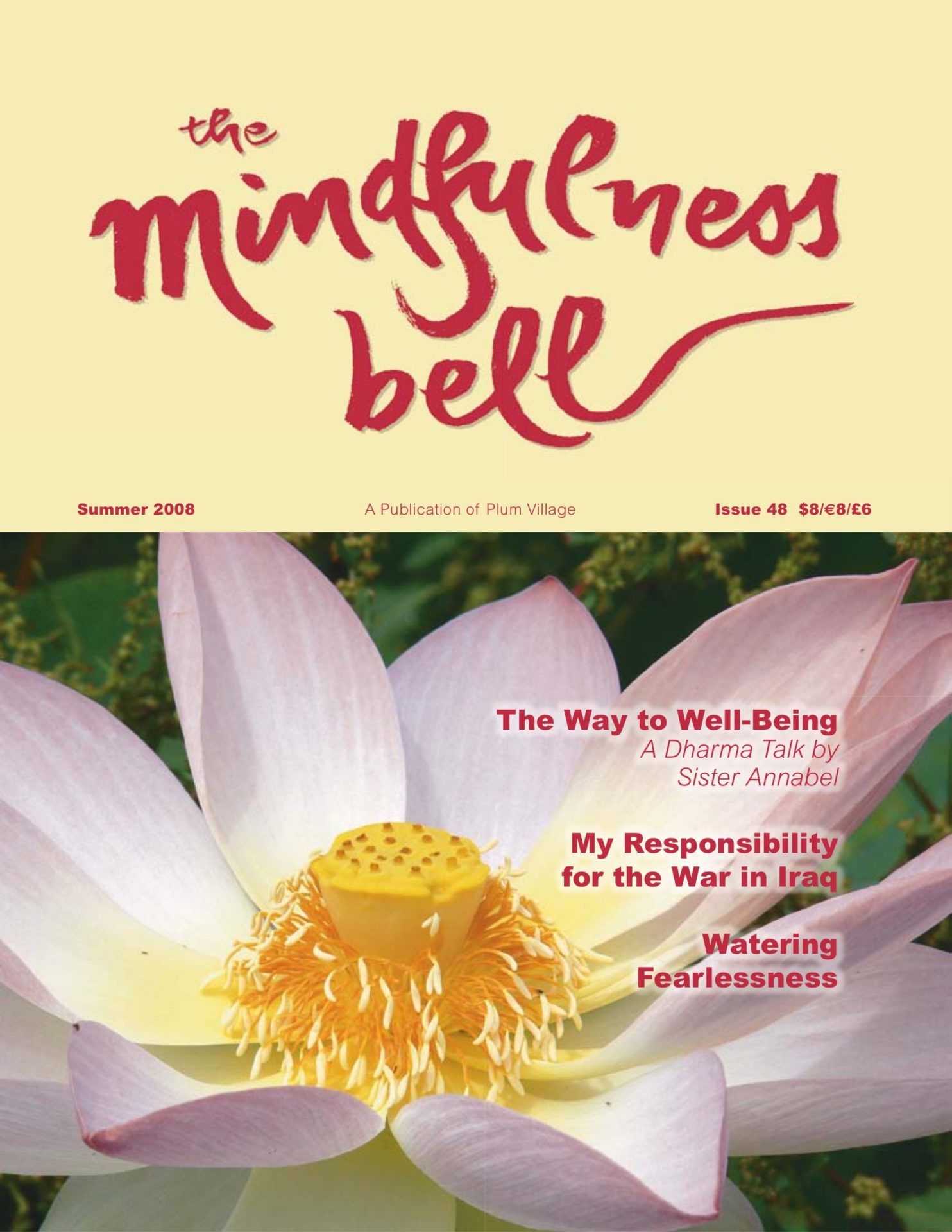A Mantra (or Two)
By David C. Gritz


Sometimes life presents us with very intense training opportunities for our practice. Probably you are familiar with those “opportunities” for learning. We didn’t ask for the experience and we wouldn’t choose it, if we were given a choice. But regardless of how we wish reality would be, it isn’t like that. It’s like this and here we are,
A Mantra (or Two)
By David C. Gritz


Sometimes life presents us with very intense training opportunities for our practice. Probably you are familiar with those “opportunities” for learning. We didn’t ask for the experience and we wouldn’t choose it, if we were given a choice. But regardless of how we wish reality would be, it isn’t like that. It’s like this and here we are, in the middle of it!
A while back, I was headed to a family retreat at Deer Park. I needed the quiet time and was looking forward to being immersed in four-fold sangha, as well as speaking with my monastic brothers and sisters. As I was driving to Deer Park with my two children, we were listening to Green Day’s song “Novocain.” I began crying, because the song’s request for Novocain to take away the pain of life’s trials hit home so strongly. I so wanted relief from the pain of constantly trying to face the difficulties!
For months prior to that moment, life had been offering a series of very intense training opportunities. I felt as if I was being punched in the stomach, not just once in a while, but several times a day or several times a week. There were too many things to detail here, but I’ll give some examples.
I work as an ophthalmologist, specializing in a group of very serious eye diseases that can result in blindness. Despite offering patients the latest and best eye care possible, some people still lose vision. Studies have shown that people fear losing vision even more than they fear death or any other loss. So in my medical office, in addition to many people with very severe diseases, there are people with lots of fear and anxiety and frustration.
Over the course of a month, there were three patients who lost vision in their only good eye.
One was a woman in her sixties who had lost the other eye to glaucoma. She always inspired me by her zest for life despite her limited vision. Shortly after we first met, I did a cornea transplant in her one good eye and her vision improved from blindness to 20/20 (although she only had tunnel vision due to glaucoma). It was a much better result than we had expected. But the transplant was rejected in less than a year, and after a series of eye problems she lost all vision in her only eye.
Another nineteen-year-old patient came to me with a very severe eye disease that caused blindness in one eye and constant, severe pain. When we first met, she was always doubled over in pain. With very strong medication, she improved and no longer had pain. Her family was so happy with the wonderful transformation, as she returned to be the bubbly, joking person she had been before the constant pain. She still had 20/20 vision in the other eye. Within days of the visit when we were all happy with how well she was doing, another disease attack occurred and she lost vision in her good eye. With additional strong medicine, the vision returned. This cycle repeated a number of times and each time the vision came back. But then an especially severe attack occurred and the vision was permanently lost.
The third patient who lost vision in his only eye was a single father with a young developmentally disabled son. A very good doctor had made a bad decision to do surgery in the patient’s only eye. A rare complication occurred and the patient was sent to me. After months of intensive treatment including two surgeries, we realized there was no hope of improved vision.
During that same month when these three patients lost vision, I found out I was entangled in a lawsuit. Another patient with severe eye disease had been referred to me for treatment. Despite intensive treatment, she lost some peripheral vision in one eye. She brought a lawsuit because of the outcome. I was surprised because I perceived that she and I had a very good relationship. It was difficult to think that even when I had done everything that was possible and could see nothing to change (upon reviewing the medical chart in detail) I would get sued.
In the following month, another lawsuit emerged from the third patient I mentioned above. In addition to these patient-related issues there was a variety of other difficulties at work with coworkers and supervisors, challenges at home, and family difficulties.
My formal and informal mindfulness practice was of great help in dealing with these challenges and enabling me to still see the joys of the present moment. However, after more than six months of this ongoing assault, my energy was very low and my resilience in the face of adversity was waning. With each new blow I would think, “How can I deal with this? I need to face it and deal with it, because this is my practice. I have no other choice. But how?”
Water the Seeds of Non-Fear
At Deer Park, I asked Sister Dang Nghiem for her advice about these situations and my waning energy. “How can I help to rejuvenate myself and maintain my energy, so I don’t feel so drained?” I asked. She suggested that I deepen my practice through watering the seeds of non-fear.
I was uncertain how to go about this. I didn’t perceive the presence of fear in this situation and didn’t know how to water the seeds of non-fear. I spoke to my teacher, Lyn Fine, after I returned home. Lyn explained that fearlessness can help us face difficult situations and maintain our energy when faced with adversity. Lyn had several ideas for cultivating fearlessness. One of these suggestions was to find a mantra that would help to face each moment with fearlessness.
“And This Too!”
Lyn told me about Maha Ghosananda, the Cambodian patriarch, who was asked, “What is the essence of practice?”
In response to the question, he replied: “Here.
“Now.
“And this too!”
He said “And this too!” with a joyful, fresh voice that conveyed equanimity — whether the phrase was in reference to the blue sky, the lush green of the rice paddies, or the killing fields.
I started using “And this too!” as a mantra to go with my breathing, throughout my days at work and home.
I also explored finding another mantra. There is a song in Portuguese that I love, called “The Blower’s Daughter.” One line in the chorus is “É isso aí” (pronounced eh EES-oh ee), which means, “And so it is.” I loved the melodious sound and rhythm of “É isso aí,” in addition to the meaning, and I began using this mantra also. When a difficult situation arose, I would use it as a chance to take a breath and say silently (or sometimes aloud), “É isso aí!” When a wonderful moment arose, it would be another chance to take a breath and say, “And this too!”
A typical response prior to starting the practice of “É isso aí!” could have left me feeling downcast as I mumbled inside, “Oh, boy. Woe is me. And THIS, TOO!” Instead, a fresh “And this too!” or “É isso aí!” helped me to see glimpses of humor and irony. When another potential “punch in the stomach” occurred, the mantra helped to quiet my mind and keep it from running on, telling me stories about how this blow was going to lead to other problems in the future.
Over time, situations changed and my experience gradually transformed. With the mantra practice, feelings of equanimity for the situations grew stronger. This particular practice helped me to more deeply experience the reality of impermanence and touch the precious jewel of the present moment, finding a unique and difficult-to-describe joy, even in the difficult moments. Through this practice, I continue to look for better understanding of my suffering and to experience transformation.
“É Isso Aí,” sung by Seu Jorge and Ana Carolina on the CD and DVD, Ao Vivo: Live. The original song was written in English and is called “The Blower’s Daughter,” music and lyrics by Damien Rice.

David C. Gritz, Truly Embracing Compassion, previously lived in Berkeley, California and attended Morning Light Sangha. He has relocated to Kansas City with his family, where he enjoys the sangha fellowship of the Heartland Community of Mindfulness.

